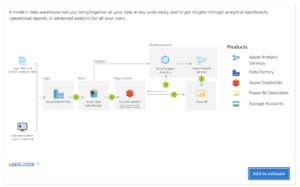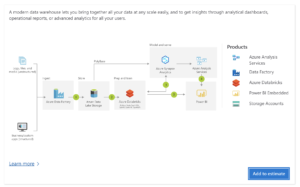The growth of the cloud market isn’t slowing down. Gartner is forecasting that the worldwide public cloud services market will grow 17% in 2020 to total $266.4 billion. That stat, coupled with Forbes prediction that over 83% of workloads will be in the cloud by the end of the year, demonstrates that organisations all over the world are scrambling to reap the benefits of the modern cloud.
There are a number of enterprises leading the charge, that are already leveraging the huge range of cloud services including artificial intelligence, IoT, analytics and more to transform and innovate faster, edging out their competition and winning the battle for customers.
As the cloud starts to mature and the suite of services that cloud platform providers such as Microsoft Azure can offer, more and more organisations are encouraged to move to the cloud for innovation but also for the significant cost savings that can be achieved.
And there are significant, well-documented cost savings to be had when migrating to the cloud. But there are also new costs and new operating models to be considered. If these costs aren’t managed properly, there is a significant risk to your organisation. We’ve seen instances where even a simple scalable database can generate tens of thousands of pounds worth of “secret” cost from incorrect management.
Cloud cost optimisation
So what are these secret costs? And how do you manage them to ensure that migrating to the cloud can add both immediate and long term commercial value to your business?
Usage
When you begin planning any cloud migration project, accurately forecasting costs is a crucial part of realising the benefits of the cloud. There are a number of factors that drive usage costs in the cloud and although historically, cloud computing costs were notoriously complex, many cloud platforms such as Azure have taken steps to simplify this process with accessible pricing calculators.
There are three axis of costs associated with usage. Standing-charge, consumption and bandwidth (data). The Azure pricing calculator can give you accurate quotes for specific products and services but it also enables you to build customisable estimates for entire scenarios. Say you’re in the planning stages of migrating an on-prem data warehouse to a modern data lake solution to facilitate better analytics into your business.
You can build the entire scenario including Data Factory for data ingestion, the Data Lake itself for storage (more on that in a moment) as well as tools to enable data analysis such as Synapse Analytics and to visualise the insights you extract from the data such as Power BI.

You can then configure your specific requirements for each product, including usage, storage and support options giving you a detailed and accurate monthly cost estimate for your entire solution. The ability to configure and estimate costs at this level is a game-changer in managing the “secret” costs of the cloud.
Data storage
When it comes to storing your data in the cloud, the benefits are well documented. There is often no upfront cost, no termination fees and you only pay for what you use which should provide immediate cost efficiencies if you’re switching from a traditional on-premises environment.
There are a number of flexible options to choose from. From low-cost scalable object storage through to data lakes and persistent, secure managed disks that support simple and scalable virtual machine deployment. But if you’re not careful about selecting the best option for your project, you could be walking into a sack of unforeseen and unanticipated costs that diminish the ROI you can achieve.
When identifying the best option, you need to think about…
- The purpose for which the data exists. Your choice depends on the way in which the data will be accessed and consumed. Hot and cold data are common terms used to categorise usage patterns at a high level. Hot data is regularly accessed, while cold data is considered archival storage, cost-wise the former decreases transaction costs relative to storage while the latter considers the opposite.
- The structure in which you want to store and access your data will also affect your choice, running the gamut from unstructured ‘blob’ storage, through document (NoSQL) and relational databases.
- Other cloud services in your architecture will also determine the kinds of storage that are appropriate to your needs, with certain service-to-storage connections being built-in capabilities. Generally speaking, the ‘colder’ your data and the less structured your data requirements are, the cheaper it will be to store in the long term.
Any data strategy should consider the lifespan of your data and should include both hot and cold store options with data transitioning from one tier to another as usage requirements shift with the age of the data - in this way you can optimise data efficiency and cost for your solutions.
Any data strategy should consider the lifespan of your data and should include both hot and cold store options with data transitioning from one solution to another as usage requirements shift with the age of the data - in this way you can optimise data efficiency and cost for your solutions.
Data egress
Managing the costs of data in your cloud environment is important but you also have to carefully manage the cost of the data coming out. Data egress refers to any data leaving your cloud services in transit to an external location. Outbound email messages, files or data being moved to external storage or pulling data into a hybrid cloud environment are all relevant examples of data egress.
When designing any cloud solution you should carefully consider how large quantities of data will be used and consumed - if terabytes of data are to be uploaded to a cloud provider only to have that data pulled back down for processing, then there will be a high egress cost for little benefit. Processing of data in the cloud will reduce such egress costs, but beware of egress costs between regions or service centres - especially with regard to disaster recovery and failover (data-duplication) strategies.
Each instance of data egress can attract a cost, which is often missed when building new solutions or modernising applications. These unforeseen costs can often stifle the ROI of projects that are reliant on 3rd party software or SaaS products.
When planning for a net-new development, modernisation or migration project you need to ensure you correctly map your infrastructure and estimate your egress costs. Azure has another calculator for this with clear tiers to help you build an accurate estimate.
Summary
Moving to the cloud has numerous benefits, access to innovation, reducing friction to change and cost reduction if you know what to look for. If you’re able to identify and manage the secret costs of the cloud effectively, you’ll be able to guarantee a successful project.
Once you’ve migrated, you can focus on making the most of the full suite of cloud services your platform provides such as microservices and platform as a service.
Want to discuss a cloud migration project with one of our Azure accredited migration experts? Reach out at hello@dootrix.com.





